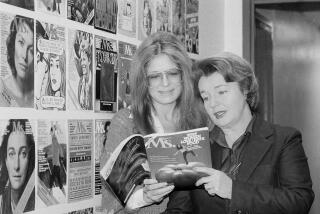At Glamour’s Helm, a Chief Who Delivers
- Share via
Every journalistic twitch, every controversial cover, every editor who wins or loses in the game of musical chairs seems to bring magazines like the New Yorker and Vanity Fair gossipy media attention. Much of this coverage owes to editors like Tina Brown, who adorned Vanity Fair with such displays as a nude and pregnant Demi Moore and is now generating even more ink as she knocks out walls at the New Yorker.
Yet for all the column inches lavished on these two magazines in the Newhouse media empire, a well-founded assumption is that the enigmatic S. I. Newhouse Jr. can fool around with his glitzy properties because he has Glamour to cover any losses.
Glamour editor-in-chief Ruth Reinke Whitney gets it done and goes home to the suburbs. “I’m not one of the people they gossip about,” she says, “and that’s fine with me.”
Whitney--who was born in Oshkosh, Wis., is married and has one child, a son, who works at Time Inc.--has been the editor of Glamour for 26 years. That’s an eternity in a line of work known for rapid turnover, and especially so at Newhouse’s Conde Nast Publications.
Whitney inherited a fashion mag with white-glove concerns and turned it into a harder-edged, feminist book that belies the frothiness in its name by emphasizing the abortion-rights argument, sexual understanding, consumer coverage--and refreshingly little celebrity puffery--along with the requisite fashion sense.
For the October issue, which will look at women’s roles in the Midwest floods, Whitney also is pressing against deadline to accommodate an eleventh-hour interview with new Supreme Court Justice Ruth Bader Ginsburg.
The score card shows that circulation on Whitney’s watch has grown from 1.4 million to more than 2 million. Glamour is the second biggest seller in college bookstores, behind Cosmopolitan. Advertising revenues totaled an estimated $100 million last year, which represented a 10% increase over 1991, and income from the million or so copies sold each month on newsstands, more profitable than subscription sales, doubtless makes Glamour a Conde Nast gusher.
In terms of editorial quality, until 1991 Glamour had been the only women’s magazine nominated for the top industry honor, the National Magazine Award for general excellence, and it was a finalist for the award again last year alongside Business Week, Vanity Fair, Health and Newsweek (which won). Whitney is 65 years old, but has no plans to retire.
“Not ready yet,” she says. “This is a very exciting job and I’m a round peg in a round hole. I really fit here.
“I realize this sounds ridiculous, but I am still learning, fast and furiously. And partly this is because the audience has changed so much--in many ways it’s been many different versions of Glamour that I’ve been editing.”
Whitney at first encountered a feeling at Glamour that women would get ahead by learning the niceties of life. But she challenged the prevailing definition of Glamour--and glamour--in ways that seem obvious 26 years later.
In one of her early innovations, an annual contest to find the best-dressed college women became a quest for the top 10 achievers. Then Whitney wanted to feature a black achiever, Katiti Kironde, on the August, 1968, cover. Kironde became the first African-American to be featured on the cover of a mainstream women’s magazine.
“That move had to be OKd all the way up to the president of Conde Nast, and there was much consternation about it,” she says. “For one thing, it had never been done, so nobody knew what would happen. They didn’t know whether they’d lose their wholesale distributors. They didn’t know whether advertisers would pull out from the next issue--because we didn’t tell anybody. The concern about perception was an overriding one, but there was a financial concern too.
“But the good part of the story is that it was the largest sale in Glamour’s history. The audience was out there just waiting for it. Women’s magazines were so fearful back in those days, just so fearful. And it wasn’t a scary thing to do at all once you’d done it.
“I was definitely pleased with myself. What was even better was that the company was pleased with me.”
Of her relationship with the Newhouse management, Whitney says, “Glamour works and it has always worked. And for the most part they just stay out of your way, if your product works.”
More to Read
Sign up for our Book Club newsletter
Get the latest news, events and more from the Los Angeles Times Book Club, and help us get L.A. reading and talking.
You may occasionally receive promotional content from the Los Angeles Times.










